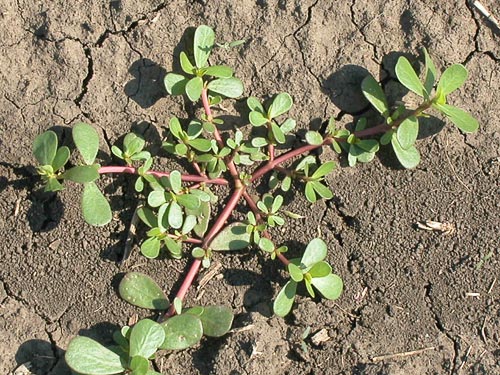Weeds
Portulaca oleracea L. - Common purslane.
Systematic position.
Family Portulacaceae Juss., genus Portulaca L.Biological group.
A late summer eutherophyte.Morphology and biology.
Caulis 10-35 cm in length, bare, pulpy, extended, more often lying on the ground or erect, branching from the base. Leaves alternate, upper ones almost opposite, sessile, cuneiform-inverse-oval, oblong-cuneiform, spatulate, blunt, narrowing towards the base, pulpy, 1-2 cm in length and 0.5-1 cm in width. Stipules scarious, reduced often to small-sized setae. Flowers single or 2-3 ones in fascicles, sitting in bifurcations of a caulis or in sinuses of leaves, 8-12 mm in diameter. Ovary semiinferior. Two sepals are blunt, each with mitriform apex above; anterior ones larger than posterior, embracing the last ones; falling off during fruiting. 4 to 6 petals are present, ovoid in shape, yellow, early falling; the stylus with linear stigmae deeply divided into 3 to 6 branches; 6 to 15 stamens. The fruit is capsule, ovoid or roundish, 5-8 mm in length, unilocular, loculicidal. Seeds are numerous, reniform, brown-black, obtusituberculate, shiny, 5-7 mm in size. Blooming from June until September.Distribution.
West and South of the European part of CIS, Crimea, the Caucasus, Central Asia, the Far East, Middle and Southern Europe, Mediterranean, Iran, India, the Himalayas, Mongolia, Japan, China.Ecology.
The species grows quite often on sandy and sandy coarse gravelly alluvial soils. Grows in regions with a warm climate. Thermophilous and hygrophilous plant. One plant produces up to 1 million very small seeds germinating at temperatures 25-35 degrees C and higher (52-54 degrees C). One plant can have up to 3-4 seed generations during a vegetation season because of immediate germination of fresh seeds. Seeds germinate on soil surface or from a depth no more than 1.5 cm; seeds remain capable of germinating in soils up to 30 years. Plants are very persistant. Uprooted plants remain green for a long time, and uprooted plants can reroot quickly in wet conditions.Economic significance.
Weed in technical and vegetable cultures (cotton, corn, soya, alfalfa, and others), especially on irrigated lands. Control measures include crop rotation, land treatment pre-winter plowing, early treatment with a cultivator, and application of protection chemicals if necessary.Reference citations:
Burygin V.A., Dzhangurazov F.H. 1975. Weed vegetation of the irrigated lands of Uzbekistan and biological bases of it control. In: Belov A.I., Burygin V.A., Kamilova F.G., eds. Weed vegetation of the irrigated lands of Central Asia. Proceedings of Tashkent agricultural institute. Tashkent: Tashkent agricultural institute. 1-7 p. (In Russian)Gaidashakin V.I., Makashvilli A.K, Yabrova V.S., Yaroshenko P.D. 1936. Weed plants of wet subtropics of the USSR and their control. N. 31. Sukhumi. 30p.
Komarov V.L., ed. 1936. Flora of the USSR. Moscow-Leningrad. V. 6: 386. Mal.tsev A.I. 1962. Weed vegetation of the USSR and its control. Leningrad-Moscow: Izd-vo sel.skokhozyaistvennoi literatury, zhurnalov i plakatov. 173 p. (In Russian)
Ul.yanova T.N. 1998. Weed plants in the flora of Russia and other FSU countries. St. Petersburg: VIR. 218 p.


